Flavin-mediated extracellular electron transfer in Gram-positive bacteria Bacillus cereus DIF1 and Rhodococcus ruber DIF2
- PMID: 35540069
- PMCID: PMC9076428
- DOI: 10.1039/c9ra08045g
Flavin-mediated extracellular electron transfer in Gram-positive bacteria Bacillus cereus DIF1 and Rhodococcus ruber DIF2
Abstract
Flavin-mediated extracellular electron transfer was studied in two Gram-positive bacteria: Bacillus cereus strain DIF1 and Rhodococcus ruber strain DIF2. The electrochemical activities of these strains were confirmed using amperometric I-t curves and cyclic voltammetry (CV). Spent anodes with biofilms in fresh anolytes showed no redox peaks, while new anodes in the spent broth showed relative redox peaks using CV measurements, indicating the presence of a redox electron mediator secreted by bacteria. Adding riboflavins (RF) and flavin mononucleotide (FMN) improved the electron transfer of the microbial fuel cells inoculated with the two strains. The redox peaks indicated that flavins existed in the anolyte, and HPLC analysis showed that RF and FMN were secreted by the two bacterial strains. The concentration of RF increased until the bacteria grew to the log phase in microbial fuel cells. The concentration of RF decreased and that of FMN increased after the log phase. The two strains secreted FMN only in the microbial fuel cell. These results confirmed that the electrochemical activity mediated by flavins and FMN is essential in the extracellular electron transfer process in the strains DIF1 and DIF2.
This journal is © The Royal Society of Chemistry.
Conflict of interest statement
There are no conflicts of interest to declare.
Figures
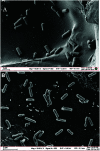
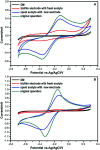
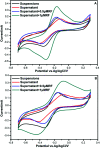
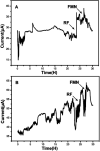

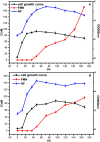

Similar articles
-
Flavins mediate extracellular electron transfer in Gram-positive Bacillus megaterium strain LLD-1.Bioelectrochemistry. 2018 Feb;119:196-202. doi: 10.1016/j.bioelechem.2017.10.005. Epub 2017 Oct 16. Bioelectrochemistry. 2018. PMID: 29055859
-
Flavin mononucleotide mediated electron pathway for microbial U(VI) reduction.Phys Chem Chem Phys. 2010 Sep 14;12(34):10081-7. doi: 10.1039/c0cp00339e. Epub 2010 Jul 12. Phys Chem Chem Phys. 2010. PMID: 20623083
-
Electrochemical Study on the Extracellular Electron Transfer Pathway from Shewanella Strain Hac319 to Electrodes.Anal Sci. 2018 Oct 10;34(10):1177-1182. doi: 10.2116/analsci.18P237. Epub 2018 Jun 15. Anal Sci. 2018. PMID: 29910222
-
[Chemical and functional properties of flavin coenzymes].Nihon Rinsho. 1999 Oct;57(10):2193-8. Nihon Rinsho. 1999. PMID: 10540861 Review. Japanese.
-
Extracellular electron transfer features of Gram-positive bacteria.Anal Chim Acta. 2019 Oct 17;1076:32-47. doi: 10.1016/j.aca.2019.05.007. Epub 2019 May 7. Anal Chim Acta. 2019. PMID: 31203962 Review.
Cited by
-
Growth and genome-based insights of Fe(III) reduction of the high-temperature and NaCl-tolerant Shewanella xiamenensis from Changqing oilfield of China.Front Microbiol. 2022 Dec 5;13:1028030. doi: 10.3389/fmicb.2022.1028030. eCollection 2022. Front Microbiol. 2022. PMID: 36545192 Free PMC article.
-
Electrochemical and spectroelectrochemical characterization of bacteria and bacterial systems.Analyst. 2021 Dec 20;147(1):22-34. doi: 10.1039/d1an01954f. Analyst. 2021. PMID: 34874024 Free PMC article. Review.
-
Isolation and Characterization of Bacteria with High Electroactive Potential from Poultry Wastewater.Biology (Basel). 2023 Apr 20;12(4):623. doi: 10.3390/biology12040623. Biology (Basel). 2023. PMID: 37106823 Free PMC article.
-
Type IV Pili-Independent Photocurrent Production by the Cyanobacterium Synechocystis sp. PCC 6803.Front Microbiol. 2020 Jun 25;11:1344. doi: 10.3389/fmicb.2020.01344. eCollection 2020. Front Microbiol. 2020. PMID: 32714295 Free PMC article.
-
Hemin-binding DNA structures on the surface of bacteria promote extracellular electron transfer.Nucleic Acids Res. 2025 Aug 11;53(15):gkaf790. doi: 10.1093/nar/gkaf790. Nucleic Acids Res. 2025. PMID: 40842236 Free PMC article.
References
-
- Neal A. L. Rosso K. M. Geesey G. G. Gorby Y. A. Little B. J. Geochim. Cosmochim. Acta. 2003;67(23):4489–4503. doi: 10.1016/S0016-7037(03)00386-7. - DOI
LinkOut - more resources
Full Text Sources

